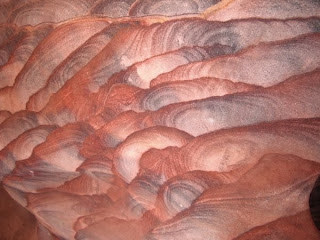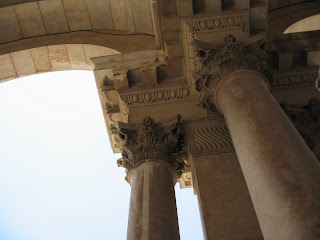On the road again! We were up early, bleary-eyed again to board the bus and find our way back to Delhi. The morning was beautiful, warm and clear, but not many of us saw the dawn sky because as soon as most of us hit the bus seat, we were fast asleep again. The countryside had the same drowsy, Indian timeless aura, with animal huts plastered with drying dung patties and water buffalo wallowing in the streams. Here’s a picture of some of them.

We arrived back at our hotel and met the rest of our group, so now there were 26 of us ready to visit Parliament. We were told to bring nothing but our passports and that security would be tight. Well, we were frisked and went through a metal detector, but no one checked our passports, so maybe Parliament knows and trusts Touro by now or security isn't as tight as advertised. The Parliament is a huge, round building (sort of shaped like a drum or a big doughnut) with a large garden in the center "hole". It was built by the British in the early 20th century and has a ponderous feel. After the bombings in Parliament a number of years ago, public visits to Parliament were curtailed, so our invitation to tour the building and meet with officials has always been a special privilege. We were ushered into a large conference room where every seat had a microphone, and we introduced ourselves to a room full of Parliamentary officials. They treated us like we were visiting dignitaries, patiently answered our questions, explained how the Parliament works and then hosted a lovely reception, with Indian delicacies, tiny delicate sandwiches and an elaborate cake. Why we deserve such gracious treatment I don’t know, but Indian hospitality is practically limitless and it was on display. So the world’s largest democracy pampered our small, not-very-important group. The Parliament chambers were huge, dignified and very old - the patina of time and weighty decisions hung about every room. The only modernity that we could see was the electronic voting system. We tried an experimental vote, but most of us had some difficulty mastering the sequence of button clicks to register our vote, so we flopped, sorry to say and the government of India did not get to learn how we voted on the important question of whether we were enjoying our trip to India. Most moving of all was the Joint chamber where both houses of Parliament meet together. It was in this chamber at midnight on August 15, 1947 that Indian independence was declared in a famous and magnificent speech by Nehru. To be in the same spot where Indian independence began and the fulfillment of Gandhi’s campaigns of non-violent protest was realized - well, it was intensely stirring.
The next morning, again, we rose with the dawn and boarded our bus. The trip to Shimla was long, uneventful and blessedly shorter than we anticipated. We drove through the agricultural fields of Harayana, past fields of all sorts of crops and huge chicken barns. Strange, for a mostly vegetarian country, this part of India produces huge numbers of chickens. Finally we got to the hills and then our journey began its winding, switchback, bumpy, jolting progress up into the Himalayan foothills. Arriving at Shimla at night is magical - the lights of the city glow in a rainbow of colors and spill down the hillside, like a cascade of gems. You just catch your breath when Shimla first comes into view. The air is cooler here, the pines are tall and straight and the mountain views stunning. So, a bit bedraggled we were met at our hotel by warm and friendly faces and a large buffet that was waiting for us. Again, the hotel entrance was fronted by a magnometer, spoiling the hotel’s traditional entry. We are so well treated by our hotel staff here in Shimla- it feels like visiting an over-indulgent friend.
Sunday was a day to rest, unpack, explore the city and prepare for classes. So explore we did and most came back with armloads of great bargains. It was the beginning of serious, heavy-duty shopping that never seems to end in Shimla. Our opening reception featured a talk by the Director General of Police for the state of Himachal Pradesh (a good person to know). What a resume! Trisha started to read it and then gave up - it was too long. He had degrees in German, business, physics, yoga and others that I can’t remember. We peppered him with questions, especially our students from India, who pressed him on many points, especially police corruption and disregard of rules, so it was a good discussion.
All of Shimla seems spruced up for our visit. The Gaity Theater has been restored and is now presenting performances and entertainment. It was a theater for musicals and other performances during the British Raj when the British decamped to Shimla to escapee the heat of the plains. But it had crumbled from neglect in recent decades and has been in some state of restoration for the last few years. Now it is glowing. There musts have been a big sale on lavender paint, because it seems that half of Shimla is newly painted with it. The police barracks is a lovely shade of pale lavender, with a bright green roof, and many homes sport this lively shade as well. The YMCA has been painted a bright, clear red, so the building on the hillside can be spotted from miles away. Houses are pale apricot, with electric pink trim or deep blue with traditional red roofs - this has become a very colorful place.
By Professor Marianne Artusio, Touro Law Summer Abroad Program in India 2010















































